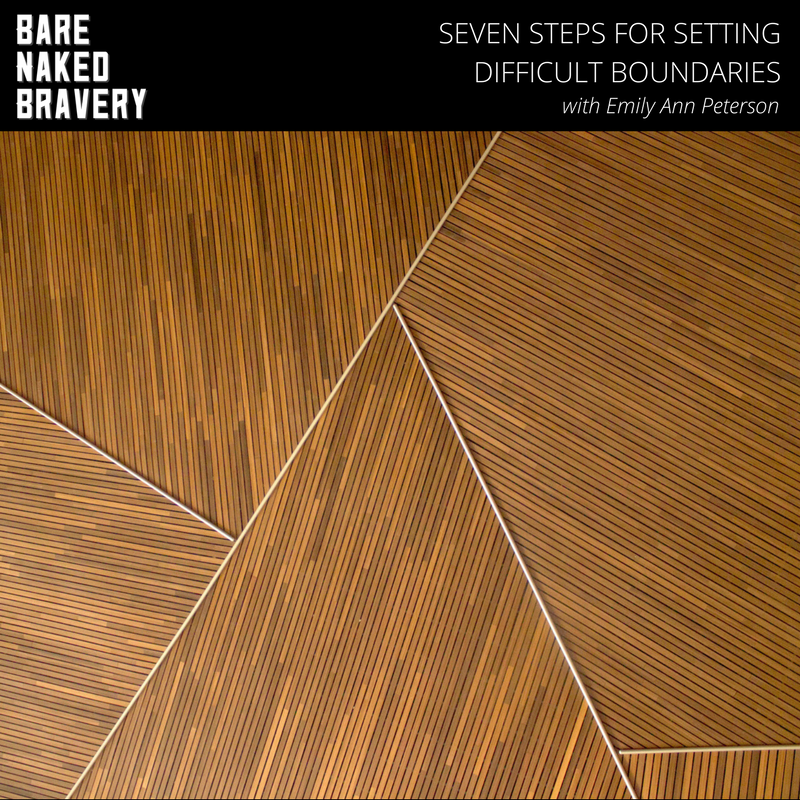ps019: Seven Steps to Setting Difficult Boundaries

FYI - A version of this podcast episode was also featured on Fons Amplify.
If you’re reading or listening to this, most likely you’ve found yourself at one time or another feeling like a friend, family member, client, or student has stepped on your toes.
Maybe a client is chronically late to their appointments? Maybe they go way over their allotted time with you? Maybe someone is perpetually late payments? Or they arrive with last minute and unreasonable demands? Maybe they talk over you while you’re trying to say something important?
Emotional boundaries, relational, or professional boundaries — getting those lines crossed does not feel good. Speaking from personal experience, it causes me to be the kind of person that I’m not always proud of (because I’m second-guessing myself, trying to catch my breath, or worse coming from a place of defensiveness and fear).
It doesn’t matter whether I’m speaking with a student, conversing with a family member, discussing performance details with a venue, or working with a marketing client, here’s what I’ve learned about setting difficult boundaries that have already been crossed:
1. Find Your No
Before I was performing as a songwriter, I was a cello teacher. When I first got started teaching music students, I’d get caught up in the moment of instruction and wouldn’t realize until after the appointment that a line had been crossed. I’d be standing in the door waving goodbye to the student and their (difficult) parent, only to close the door behind them and think “Why on earth do I feel so yucky? so angry? so [insert odd emotion here]?” This sensation would also happen after strange interactions with friends or family members.
I quickly learned that if I didn’t listen to that initial question, nor try to find the answer to it, then an even bigger line would usually get crossed later down the line. (Payments that were 4–8 weeks late? Yuck! Parents on their phones for the entirety of their child’s lesson? No thanks. Clients assuming I had nothing else going on that weekend? Think again.)
The first step of setting difficult boundaries is to recognize where exactly is your “no”. Even if you think they’ve only tread upon the grey area of the boundary, it’s still important to acknowledge to yourself where the definitely-not-no-way-absolutely-do-not-go-there boundary is.
Maybe for you the grey area is a client arriving 5–10 minutes late. It happens, right? But you know that 30–45 minutes late is an absolute no. Maybe a grey area is one week of misconduct due to other life stresses. But you know that two months is way too much drama. Maybe a grey area is one small verbal criticism, but 10 stingers in under 30 minutes warrants a full-stop, walk-away moment.
Identify for yourself where the no is and this will empower you while you’re setting the boundary, and also inform your future boundary setting.
2. Observe How the Line was Crossed
When you’re setting a difficult boundary, it helps to acknowledge the ingredients that made up for the crossing-of-the-line in the first place. Are they perpetually late to everything in their life? Do they not care that they’re late? Or are they forgetting? Do they need an automatic reminder? Do they need two or three automatic reminders? Is the street parking really godawful? Is the traffic that unpredictable?
Not knowing these ingredients can feel like standing knee-deep in water inside a boat while hoisting buckets of water from the hull and exclaiming: “I don’t know how on Earth this water keeps getting in here?!?!?” Take a step back and acknowledge exactly how the boundary has been encroached upon.
3. Find Your Yes
This is especially important when dealing with clients or customers (or toddlers for that matter!) Find your yes. Find the thing you want them to do. Identify the way things can ideally be. If the world were a perfect place, how would things have gone differently for the better?
Knowing your “yes” will equip you with the tools to highlight the positive rather than the negative with your client. For example, telling a toddler “Keep your food on your plate” is sooo much more effective than “Don’t throw your food on the floor!” This is because the child hears the desired behavior, rather than an enforced negative behavior. Same goes for other difficult conversations with more (hopefully) grown-up individuals.
4. Decide How to Set Your Boundary
I am such a huge fan of clear and frequent communication. I learned the hard way that if I merely sat silently, the situation would never change. That said, sometimes it is appropriate to say nothing. This is why it’s so important to decide in advance how you’d like to make your boundary known.
Perhaps laying down an iron fist policy change in a mass email to all your clients is not the best solution for this instance? Perhaps a casual problem-solving conversation is best? (Example: “I’ve noticed you’ve been late to your lesson the last two weeks. Is everything OK? Let’s brainstorm, how can I help you get here on time?”)
At one time in my teaching career, I chose to inform chronically tardy students that after 15 minutes of waiting I’d leave my teaching studio to use their appointment time for a bonus (paid for) coffee break and lock the door behind me. When they showed up 45 minutes late without notice, to a locked door and called me asking “Where are you?” it was then that I’d respond, “Oh! You weren’t here. I didn’t hear from you, so I went to run an errand and get some coffee.”
Again, different situations will warrant different methods of enforcing and informing about the boundaries. If you have observed your own responses and ingredients of the breaking-of-the-boundary, then this step will be much easier.
5. Take a Deep Breath
If your situation is asking for a roll-your-sleeves-up brave moment of speaking up for yourself, then I highly encourage taking a deep breath before making your next move. It really does help. Your brain and emotional well-being will need all that oxygen to break out of the fear-filled loop of reaction.
Get yourself grounded. Remind yourself of the all the previous steps mentioned above. Take a deep breath. Or two. Or three. And then…
6. Set the Boundary
Have the conversation. Write the text/email, press send. Do the thing.
My professional work with students and marketing clients has told me time and time again that the worst part of a scary feat is the preparation for it. Creating the website might take months, but launching it happens with the click of a button. Same goes for sending that difficult email with a new set of boundaries or having the conversation.
If this is a boundary that you’ll have to enforce frequently, know that it will get easier over time. Also, know that enforcing it is worth it.
7. Their Reaction is Not Yours
If you have intentionally and carefully done the above steps, even if everything can goes smoothly as possible, sometimes it doesn’t pan out. This is just a fact of being human, not everyone will love us equally and unconditionally. (Deep thoughts, huh?)
Depending upon the person and the boundary you’re setting, you might lose them. Your friend’s feelings might get hurt. They might feel “boxed in”. It’s important to remember that their reaction is not your responsibility. This new boundary is there to protect all parties involved. In most cases, the boundary exists to nurture the relationship, even if the nurturing comes in an uncomfortable form at first.
This is why I like to throw in the next bonus step…
Bonus! 8. Participate in Self-Care
In most cases, the setting of these new boundaries already qualifies as self-care. However, if you’re like me and you’re facing a more difficult reaction, then a post-conversational solo walk or bubble bath is in order. My personal favorite act of self-care? A good roll-down-the-windows-turn-up-the-music sing along head-bang session.
Setting difficult boundaries can be tough as nails, but I know that I’m more likely to enforce a future difficult boundary if I care for myself and my own emotions afterwards.
Knowing that you have a sense of safety, confidence, and place to be yourself in the world?
WORTH IT. So worth it.
Keep in Touch with Emily Ann Peterson
http://emilyannpeterson.com
http://instagram.com/emilyannpete
http://facebook.com/emilyannpeterson
http://twitter.com/emilyapeterson
3 Ways You Can Support the Bravery!
1. Leave a review on iTunes
We would LOVE it if you’d leave a podcast rating or review on iTunes.
Simply click here to get started >>> http://bit.ly/bnbrr
2. Share this episode with a friend
If you have a friend who might really love/need to hear this episode, what are you waiting for?! Email, text, fb message, snail mail - all great options!
3. Become a Patron of Bare Naked Bravery
Every patron gets awesome goodies, super early advance links to Emily Ann's new songs & releases, and so much more!
$1 Monthly
$3 Monthly
$5 Monthly
$10 Monthly
$15 Monthly
$25 Monthly
$100 Monthly
I'm looking forward to being with you next week. We have some great things in store for you!
Until then I have one message for you. It's this:


0 comments
Leave a comment